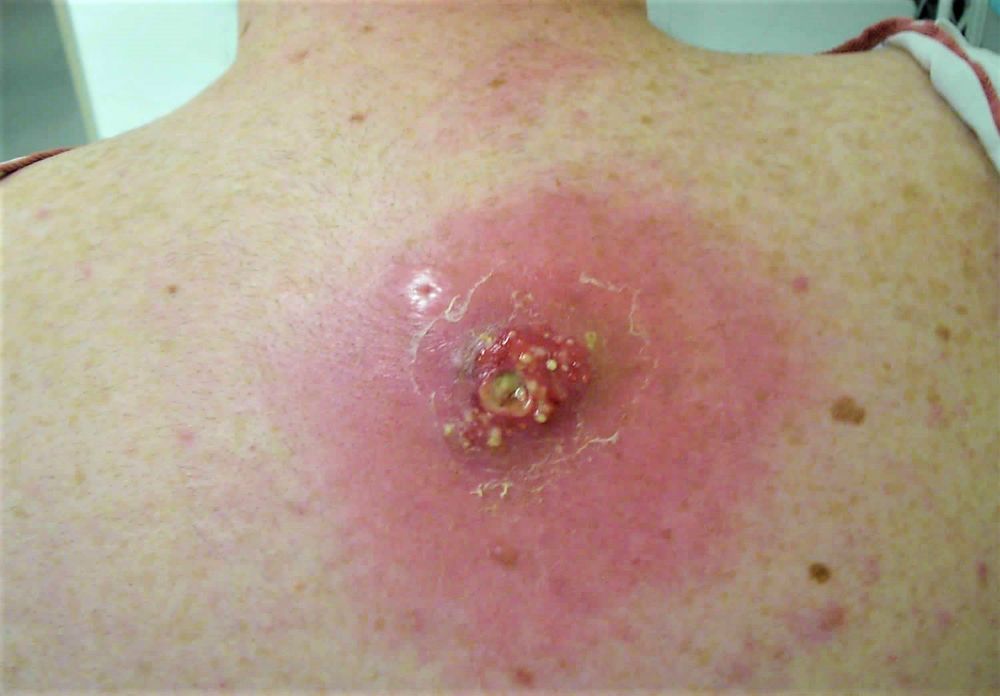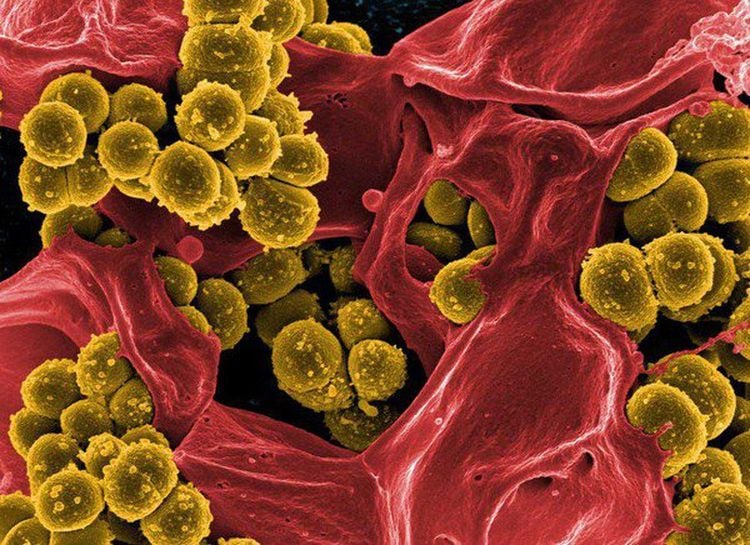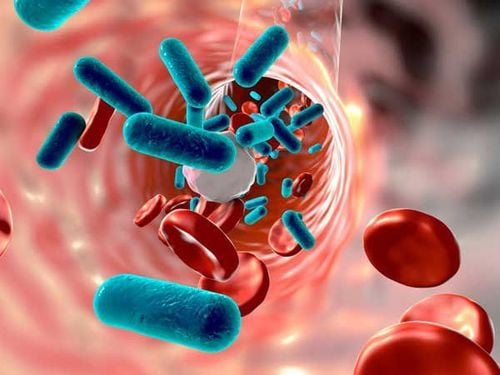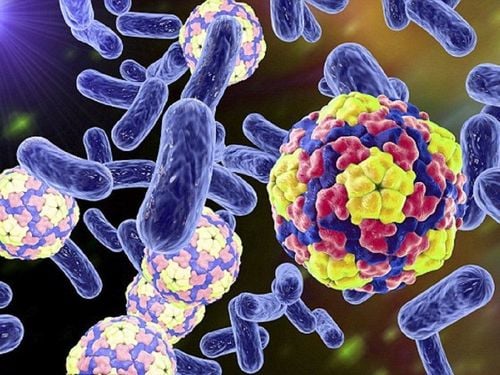This is an automatically translated article.
Staphylococcal bacteria are present almost everywhere in the natural environment, it can cause infection to people at any time, especially in summer when hot and humid conditions are favorable.1. What is staphylococcus (Staphylococcus) bacteria?
Bacteria are one of the main agents that cause infections in humans. Among them, the most common is staphylococcus bacteria (Staphylococcus).
Staphylococcus is gram-positive cocci, about 1 micrometer in diameter, they often cluster together to form clusters, shaped like bunches of grapes. Most Staphylococcus reside mainly in the skin and mucous membranes. Normally, these staphylococci are still present in the human body (mainly on the skin) but do not cause disease or cause only mild skin infections. However, when the staph bacteria get deeper into the bloodstream, joints, lungs or heart, it can lead to a serious, life-threatening infection.
Trắc nghiệm: Bạn có phân biệt được chính xác cảm lạnh và cúm mùa?
Cảm cúm và cảm lạnh là hai khái niệm mà chúng ta thường đánh đồng nó giống nhau, không phân biệt rõ ràng. Dưới đây là một số câu hỏi trắc nghiệm, giúp bạn có thêm những kiến thức phân biệt cảm lạnh và cảm cúm. Từ đó, có những biện pháp điều trị bệnh phù hợp.Currently there are about 32 species of Staphylococcus, but the most characteristic can be mentioned are 3 species:
Staphylococcus aureus (yellow staphylococci) Staphylococcus epidermis (skin staphylococcus) Staphylococcus saprophyticus (saprophytic staphylococcus) Of the three species above, common The most common is staphylococcus aureus. Staphylococcus aureus bacteria usually parasitic on the skin and nose and throat, they cause disease in people with reduced resistance. One thing that causes headaches for doctors with staph infections is their antibiotic resistance. Most Staphylococcus aureus are resistant to many different antibiotics, especially Penicillin G. Some are resistant to Methicillin.
Currently, some strains of Staphylococcus aureus are still resistant to all antibiotics except Vancomycin, the number of these strains is increasing, making the treatment of diseases caused by Staphylococcus aureus more difficult. .

Vi khuẩn chính là một trong những tác nhân chủ yếu gây ra các bệnh nhiễm trùng ở người
2. What diseases does staphylococcus (Staphylococcus) infection cause?
When the body is infected with staphylococcus bacteria (Staphylococcus), the patient will experience the following common conditions:Skin infections This condition is mainly caused by Staphylococcus aureus. Because staphylococci often live on the skin and mucous membranes, they easily penetrate through pores, hair roots or subcutaneous glands, where they cause a bacterial infection that can be accompanied by pus. The most noticeable manifestation is the appearance of abscesses, boils, and impetigo on the skin. Staphylococcal skin infections often appear in the hot season, children and infants are common subjects. In addition to the skin manifestations, the child also has a fever. The severity of the disease depends on the body's resistance. In particular, Staphylococcus also causes nailheads (also known as nails), this is an acute bacterial infection, which is life-threatening because of its high ability to cause bacteremia.
Sepsis When staphylococcus bacteria cause skin infections, they have the ability to migrate into the bloodstream causing bacteremia. This is a serious and dangerous infection because when the blood is infected, the staph bacteria easily move to internal organs such as liver, lungs, brain, marrow, ... causing abscesses in the area. these agencies. In addition, the patient also had venous thromboembolism. Some of these infections can become chronic inflammatory forms such as osteomyelitis.
Food poisoning and acute enteritis Food poisoning occurs when an infected person eats food contaminated with staphylococcus. The main reason is due to unsanitary food processing and preservation. Staphylococci directly infect food through the person who prepares it, especially when sneezing or having open wounds on hands.
Staphylococci, when contaminated with food, multiply and develop very quickly, they have very strong exotoxins and are more special than the exotoxins of other bacteria, that is at a temperature of 100 degrees Celsius within 15 minutes has not been destroyed yet. It is worth mentioning that the toxins produced by the strong growth of staphylococcus aureus do not affect the taste or feel of the food at all. This is the main cause of food poisoning caused by staphylococci.
When the number of Staphylococcus aureus bacteria in the intestinal tract increases and predominates, the patient may experience acute inflammatory bowel disease. The cause of this situation may be because the patient has been using antibiotics for a long time, especially broad-spectrum antibiotics, leading to the destruction of the beneficial bacteria in the intestinal tract that are sensitive to antibiotics. That creates favorable conditions for the development of staphylococcus aureus. Common manifestations of acute enteritis are: nausea, vomiting, diarrhea, unusual abdominal pain, loss of appetite, low fever,...
Nosocomial infection In a hospital environment, staphylococci can be cause infectious conditions such as: wound infection, burn wound infection, respiratory infection (such as pharyngitis, pneumonia, ..), urinary infection (usually caused by saprophytic staphylococcus). They are often transmitted through invasive medical equipment, open wounds or abrasions, sharing personal tools such as razors, face towels, etc. Most of the strains of staphylococcus that cause hospital infections are common. have strong antibiotic resistance.
Toxic shock syndrome This is a rare, sudden, life-threatening syndrome. The main cause of this condition is the release of toxins from staphylococci (most commonly Staphylococcus aureus and group A staph) when they overgrow. Toxic shock syndrome is common in menstruating women when they use contaminated tampons or absorbent cotton pads. Symptoms include: High fever, headache, fatigue, thirst, heart palpitations, low blood pressure, rash all over the body,...

Các tụ cầu thường sống ký sinh trên da và niêm mạc
3. How to prevent staph infection
Currently, in the world, there is still no specific vaccine to prevent diseases caused by staphylococcus bacteria. However, we can still prevent this disease by the following ways:Keep the body clean, especially in the hot season like summer. Regularly bathe daily, wash hands and maintain proper hand hygiene, brush teeth, gargle and keep throat hygiene by rinsing with physiological saline. Pay attention when bathing young children need to bathe carefully in the skin folds, between the skin because here often accumulates a lot of dirt. Do not share personal tools such as razors, towels, clothes, etc. Because bacteria can be spread from one person to another when sharing personal items. It is necessary to ensure food hygiene and safety, eat cooked and drink hot, and use foods of clear and reputable origin. Limit eating foods that have not been cooked such as rare meat, salad, spring rolls, blood pudding, ... Pay attention to storing food properly. At medical facilities, it is necessary to follow measures to ensure a sterile environment in operating rooms, properly sterilize medical instruments, preserve the environment in and around the hospital, minimize the risk of infection. bacteria spread. In case the patient has a skin infection, it is necessary to use a clean gauze bandage to cover the ulcer, to prevent the staphylococci present in the pus from spreading to other locations. For women, when it comes to menstruation, it is necessary to pay attention to keeping the private area clean, do not use tampons with too high absorbency because they cause vaginal dryness, thereby changing the vaginal pH, creating favorable conditions. favorable for staphylococci development. Change tampons often, about every 4 hours. Maintain a scientific diet and activities to improve the body's resistance.
If you have unusual symptoms, you should be examined and consulted with a specialist.
Please dial HOTLINE for more information or register for an appointment HERE. Download MyVinmec app to make appointments faster and to manage your bookings easily.
MORE:
Staphylococcal infection: Causes, symptoms, diagnosis and treatment What are the signs of staph bacteremia? Bacterial myositis: What you need to know













